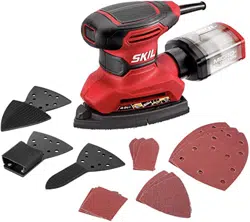Loading ...
Loading ...
Loading ...

14
SANDING: Open-coat aluminum oxide sanding sheets are recommended for most wood or metal
sanding applications, as this synthetic material cuts quickly and wears well. Some applications,
such as metal nishing or cleaning, require special abrasive pads that are available from your
dealer. For best results, use sanding and polishing accessories that are of superior quality and
are carefully selected to produce professional quality results with your sander.
The following suggestions may be used as a general guide for abrasive selection, but the best
results will be obtained by sanding a test sample of the workpiece rst.
Grit Application
Coarse For rough wood or metal sanding, and rust or old nish removal.
Medium For general wood or metal sanding
Fine For nal nishing of wood, metal, plaster and other surfaces.
Extra ne For nal sanding of bare wood, smoothing old paint, or preparing a nished sur-
face for recoating.
With the workpiece rmly secured, turn the tool
on as described above. Contact the workpiece
with the tool only after the sander has reached
its full speed and remove it from the workpiece
before switching the tool off. Operating your
sander in this manner will prolong switch and
motor life, and greatly increase the quality of
your work.
Move the sander in long steady strokes parallel
to the grain, using some lateral motion to overlap
the strokes by as much as 75%. DO NOT apply
excessive pressure — let the tool do the work.
Excessive pressure will result in poor handling,
vibration, and unwanted sanding marks (Fig. 8).
If the surface is rough, begin with coarser grits
and then complete the surfacing with medium and ne abrasives. To avoid uneven results, do not
skip more than one grit size when going from coarser to ner, and do not sand in one area for too
long. When the job is completed, gently lift the tool from the work surface and slide switch to the
“Off” position.
POLISHING: Your Multi-Function Detail sander may be tted with optional abrasive mesh or
polishing pads to polish or remove scratches or corrosion from metal, painted, or other surfaces.
The tool is operated in much the same way as when sanding, but the following points should be
observed;
•
Use light pressure and a circular or overlapping motion to remove scratches and corrosion
or polish a surface.
•
If using a compound, use only as much as necessary and do not use the dust extraction
feature.
•
When working in very conned areas or louvered panels, the pad extension plate should be
used.
• Clean the bufng or mesh pads with mild detergents and warm water. DO NOT use
solvents.
Fig. 8
Loading ...
Loading ...
Loading ...
